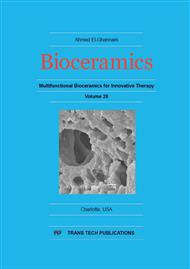[1]
Atai, M., M. Nekoomanesh, S.A. Hashemi, and S. Amani. 2004. Physical and mechanical properties of an experimental dental composite based on a new monomer. Dent Mater, vol. 20, no. 7, pp.663-668.
DOI: 10.1016/j.dental.2003.08.008
Google Scholar
[2]
Denry, I. and J. Kelly. 2008. State of the art of zirconia for dental application. Jounal of Dental Material, vol. 5, p.55.
Google Scholar
[3]
Permatasari, T., W.B. Haris, A.R. Zaini, M.R. Aufan, and B.S. Purwasasmita. 2012. Synthesis of metakaolin-zirconia-apatite nanocomposite for the application of direct teeth restoration. Solids and structures, vol. 1, pp.1-4.
Google Scholar
[4]
Guazzato, M., L. Quach, M. Albakry, and M.V. Swain. 2005. Influence of surface and heat treatments on the flexural strength of Y-TZP dental ceramic. Journal Dent, vol. 33, p.9–18.
DOI: 10.1016/j.jdent.2004.07.001
Google Scholar
[5]
Coelho, P.G., N.R. Silva, E.A. Bonfante, P.C. Guess, E.D. Rekow, and V.P. Thompson. 2009. Fatigue testing of two porcelain–zirconia all-ceramic crown systems. Dent Mater, vol. 25, p.1122–1127.
DOI: 10.1016/j.dental.2009.03.009
Google Scholar
[6]
Hannink, R.H.J., P.M. Kelly, and B.C. Muddle. 2000. Transformation toughening in zirconia-containing ceramics. Journal Am Ceram, vol. 83, no. 3, pp.461-487.
DOI: 10.1111/j.1151-2916.2000.tb01221.x
Google Scholar
[7]
Tuan, W.H., R.Z. Chen, T.C. Wang, C.H. Cheng, and P.S. Kuo. 2002. Mechanical properties of Al2O3/ZrO2 composites. J. Eur Ceram Soc, vol. 22, pp.2827-2833.
DOI: 10.1016/s0955-2219(02)00043-2
Google Scholar
[8]
Mizrahi, B. 2008. The anterior all-ceramic crown: a rationale for the choice of ceramic and cement. British Dental Journal, vol. 205, pp.251-255.
DOI: 10.1038/sj.bdj.2008.735
Google Scholar
[9]
Miyasaka T., Y. Otake, T. Yoshida, S. Miyake, M. Ito, and I. Seo. 1992. Effect of filler surface treatment on mechanical property of composite resin. Journal Dent Mat, vol. 11, no. 19, p.196.
Google Scholar
[10]
Suchetha, A., M, Apoorva, S.M. Vinaya, and D. Bhat. 2014. Nanomaterials wonders in dentistry. International Journal of Researches in Dentistry, vol. 4, no. 3, p.92.
Google Scholar
[11]
Shenglei, C., O.K. Sakurai, Shinozaki, and N. Mizutani. 1998. Particle structure control through intraparticle reactions by spray pyrolysis. Journal Aerosol Sci, vol. 29, no. 3, pp.271-278.
DOI: 10.1016/s0021-8502(97)10012-x
Google Scholar
[12]
Peshev, A., et al. 2003. Spray Pyrolysis Deposition of Nanostructured Zirconia Thin Films. Elsevier: Bulgaria.
Google Scholar
[13]
Djustiana, N., Hasratiningsih, Z., Karlina, E., et al. 2016. Hardness Evaluation of Dental Composite with Ceramic Fillers. Key Engineering Materials. Switzereland: Trans Tech Publications. Vol. 696. Pp 74 - 79.
DOI: 10.4028/www.scientific.net/kem.696.74
Google Scholar
[14]
Perednis, D. 2003. Thin film deposition by spray pyrolysis and theapplication in solid oxide fuel cells. Dissertation. Zurich: Swiss Federal Institute Of Technology Zurich.
Google Scholar
[15]
Song, et al. 2004. Ultrasonic spray pyrolysis for synthesis of spherical zirconia particles. J. Am. Ceram. Soc, vol. 87, no. 10, pp.1864-1871.
Google Scholar
[16]
Ashgriz, N. 2011. Handbook of Atomization and Sprays Theory and Applications. Springer: New York, pp.849-851.
Google Scholar
[17]
Zhang, Y., T. Qi, and Y. Zhang. 2009. A novel preparation of titanium dioxide from titanium slag. Hydrometallurgy, vol. 96, p.52–56.
DOI: 10.1016/j.hydromet.2008.08.002
Google Scholar
[18]
Multi Agency Radiological Laboratory Analytical Protocols, 2004. Sample dissolution, vol. 13, pp.1-30.
Google Scholar
[19]
Ghosh, D.C. and R. Biswas. 2002. Theoretical calculation of absolute radii of atoms and ions. Part 1. The atomic radii. International Journal of Molecular Sciences, vol. 3, pp.87-113.
DOI: 10.3390/i3020087
Google Scholar
[20]
Levin, I. and D. Brandon. 1998. Metastable alumina polymorphs: crystal structures and transition sequences. Journal Am. Ceram Soc, vol. 81, no. 8, p.1995–(2012).
DOI: 10.1111/j.1151-2916.1998.tb02581.x
Google Scholar
[21]
National Institute of Safety and Health. 2002. Health effects of occupational exposure to respirable crystalline silica, no. 149, p.145.
Google Scholar
[22]
Shirai, T., H. Watanabe, M. Fuji, and M. Takahashi. 2009. Structural properties and surface characteristics on aluminum oxide powders. Ceramics Research Laboratory, Nagoya Institute of Technology, vol. 9, pp.23-31.
Google Scholar
[23]
Hasratiningsih, Z., et al. 2016. Basic Properties of PMMA Reinforced Using Ceramics Particles of ZrO2-Al2O3-SiO2 Coated with Two Types of Coupling Agents. Key Engineering Materials Vol. 696 pp.93-98.
DOI: 10.4028/www.scientific.net/kem.696.93
Google Scholar


